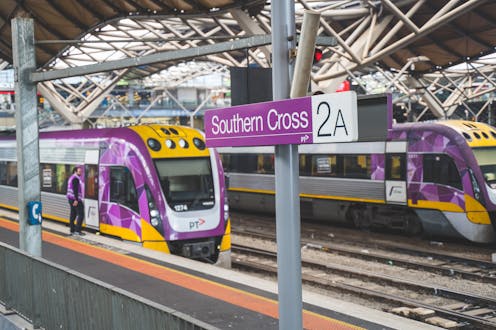Air quality at many train stations is alarmingly bad. Here’s how to improve it
- Written by Magnus Moglia, Associate Professor in Systems Science and Sustainable Urbanism, Swinburne University of Technology

Recent revelations about poor air quality at Melbourne’s Southern Cross Station probably came as no surprise for passengers who have experienced such conditions.
Train platforms, bus terminal and nearby areas have recorded alarmingly poor air quality. In some parts of the station, nitrogen dioxide levels were more than 90 times the World Health Organization’s (WHO) recommended limit. At such levels, considered much higher than medically acceptable, human health is at risk.
Poor air quality in train stations is a concern in many major cities, including Sydney, New York and Boston in the US, and London and Edinburgh in the UK. In some Sydney stations and tunnels, air pollution was up to five times worse than the WHO’s recommended limit.
Poor air quality is a result of fumes from diesel engines, restricted airflow, station design and the wear of train components. These emissions include tiny airborne particles. This fine particulate matter can cause illness and disease. Passengers, workers and nearby residents may all be affected.
Solutions already exist. Investing in technology, alternative fuels, electrification and better management of stations can improve air quality and reduce the health risks. As with COVID, people can also reduce their exposure by wearing suitable face masks, such as P2 and N95 masks.
It’s a worldwide problem
International studies show poor air quality is common in enclosed train and bus stations. Data for most stations from many cities show levels of fine particulate matter exceeded WHO guidelines.
In Sao Paolo, Brazil, a study found “time spent inside a bus terminal can result in an intolerable health risk for commuters”.
A Danish study identified much higherpollution levels of pollutants in and around diesel trains than for electric trains. Inside the diesel trains, levels of ultrafine particulate matter were 35 times higher, black carbon six times higher, nitrogen oxides (NOx) eight times higher, PM2.5 (particles with a diameter of 2.5 micrometres or less, so they can enter the bloodstream) twice as high and benzo(a)pyrene six times higher.
Read more: Commuting by subway? What you need to know about air quality
But aren’t trains a more sustainable form of transport?
In terms of sustainability and general urban air quality, trains help reduce emissions and air pollution when compared to cars and trucks in Australia. Trains transport people more efficiently, with a much smaller land, energy and emissions footprint.
The health impacts of air pollution are usually lower for train commuters than those who commute by car. However, the impacts on train commuters depend on location, the fuel used (diesel or electric) and the extent of their exposure to highly polluted air in enclosed and underground stations.
Read more: Air pollution from brake dust may be as harmful as diesel exhaust on immune cells – new study
What can be done to improve air quality?
Rail operators can do many things to help passengers breath more easily. These involve both trains and station management.
Train-side interventions include the use of cleaner fuels, more efficient engines and filtering systems, and shifting from diesel to electric trains.
Station-side solutions include exhaust fans, station design and real-time monitoring of air quality. Optimising schedules and operations can reduce train engine idling time. Loading and unloading facilities can be relocated away from congested areas.



















